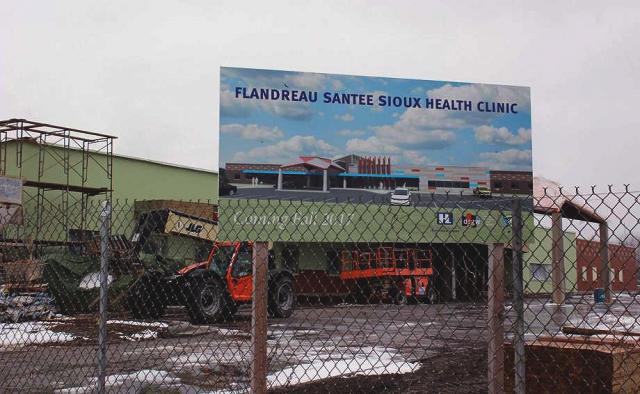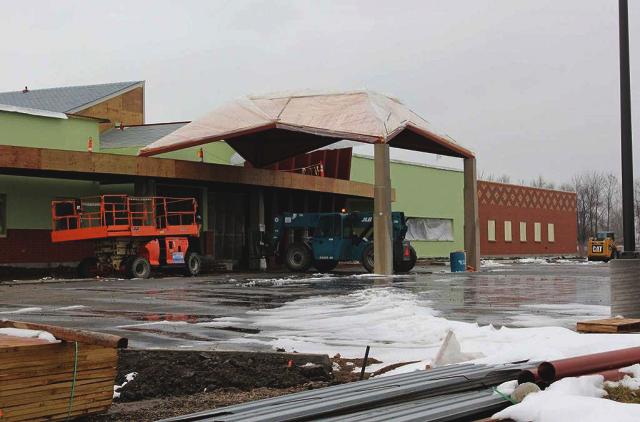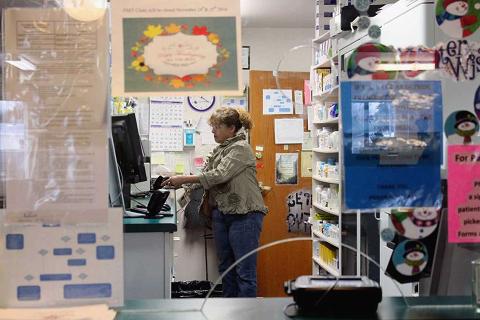 |
Canku Ota
|
 |
|
(Many Paths)
|
||
|
An Online Newsletter
Celebrating Native America
|
||
|
January 2017 - Volume
15 Number 1
|
||
|
|
||
|
Flandreau Santee
Sioux Tribe Building New $13M Clinic
|
||
|
by Regina Garcia Cano
|
||
|
credits: (photos by Regina
Garcia Cano)
|
Flandreau, SD — A clinic featuring medical, dental, behavioral and vision services will serve hundreds of members of the Flandreau Santee Sioux Tribe and students from a federally operated boarding school when it opens its doors in mid-2017 after several years of planning and a $13 million investment from the tribe. That investment by the tribe in the eastern part of the state is part of an agreement with the federal government, allowing the tribe to manage its own health care services and bypass some of the bureaucracy of the long-struggling Indian Health Service. "We are going to have more exam rooms (and) offices instead of having to use closets," tribal treasurer Ryan Kills A Hundred said. "They are doing a good job don't get me wrong, but the poor guys are working out of a tin can from the '80s ... patient privacy isn't all that great." The new facility also will have a drive-thru pharmacy — a staple in urban areas but a luxury in tribal communities — radiology services that aren't currently available, a community health educator and a public health nurse focused in nutrition.
The federal government is responsible for providing health care to enrolled members of tribes — considered sovereign nations — based on treaties, acts of Congress and other laws. The Indian Health Service, or IHS, directly operates 26 hospitals and dozens of smaller facilities, while some tribes, like the Flandreau Santee Sioux, receive the funding and administer their own facilities. The IHS has been under intense scrutiny over the past year due to federal health inspectors uncovering severe deficiencies in some Great Plains facilities
After years of seeing the underfunded agency struggle to fulfill its responsibilities, some tribal health care administrators and experts believe success lies with the tribes themselves. "Under tribal management, we tend to see greater access to funding streams that IHS could not access, and as a result, we can hire more providers and more staff," Dr. Donald Warne, the chair of the Department of Public Health at North Dakota State University, told The Associated Press earlier this year. The Flandreau Santee Sioux issued bonds to fund the $13 million project, which on a recent afternoon had construction crews working on the entrance as snow covered the ground and some equipment. The existing clinic has 30 employees and 6,000 registered patients that are members of the Flandreau Santee Sioux Tribe, other tribes and boarding school students. The new facility will employ close to 90 people, and tribal officials expect to see a small increase in patient load early on. Not every member of the tribe, whose reservation is about 45 miles north of Sioux Falls, agreed with the decision to pay for the facility, arguing that that is a responsibility of the federal government. "It became very political amongst the membership itself," Flandreau Santee Sioux tribal president Anthony Reider said. A recent federal watchdog report said IHS-managed facilities are outdated, with the average age or length of time since major renovations being 37 years — nearly four times the average age of hospitals nationwide. The need for an update at the South Dakota clinic managed by the tribe appears clear: displays for eye glasses are on top of filing cabinets, the packed pharmacy is the size of a walk-in closet and the ceiling shows the signs of a few water leaks. "We try not to point those out," said Leah Fyten, the clinic's administrator. |
||||||
|
|
|
|
||
|
|
||
| Canku Ota is a free Newsletter celebrating Native America, its traditions and accomplishments . We do not provide subscriber or visitor names to anyone. Some articles presented in Canku Ota may contain copyright material. We have received appropriate permissions for republishing any articles. Material appearing here is distributed without profit or monetary gain to those who have expressed an interest. This is in accordance with Title 17 U.S.C. Section 107. | ||
|
Canku Ota is a copyright ©
2000 - 2017 of Vicki Williams Barry and Paul Barry.
|
||
 |
 |
|
|
The "Canku
Ota - A Newsletter Celebrating Native America" web site and
its design is the
|
||
|
Copyright ©
1999 - 2016 of Paul C. Barry.
|
||
|
All Rights Reserved.
|
||


